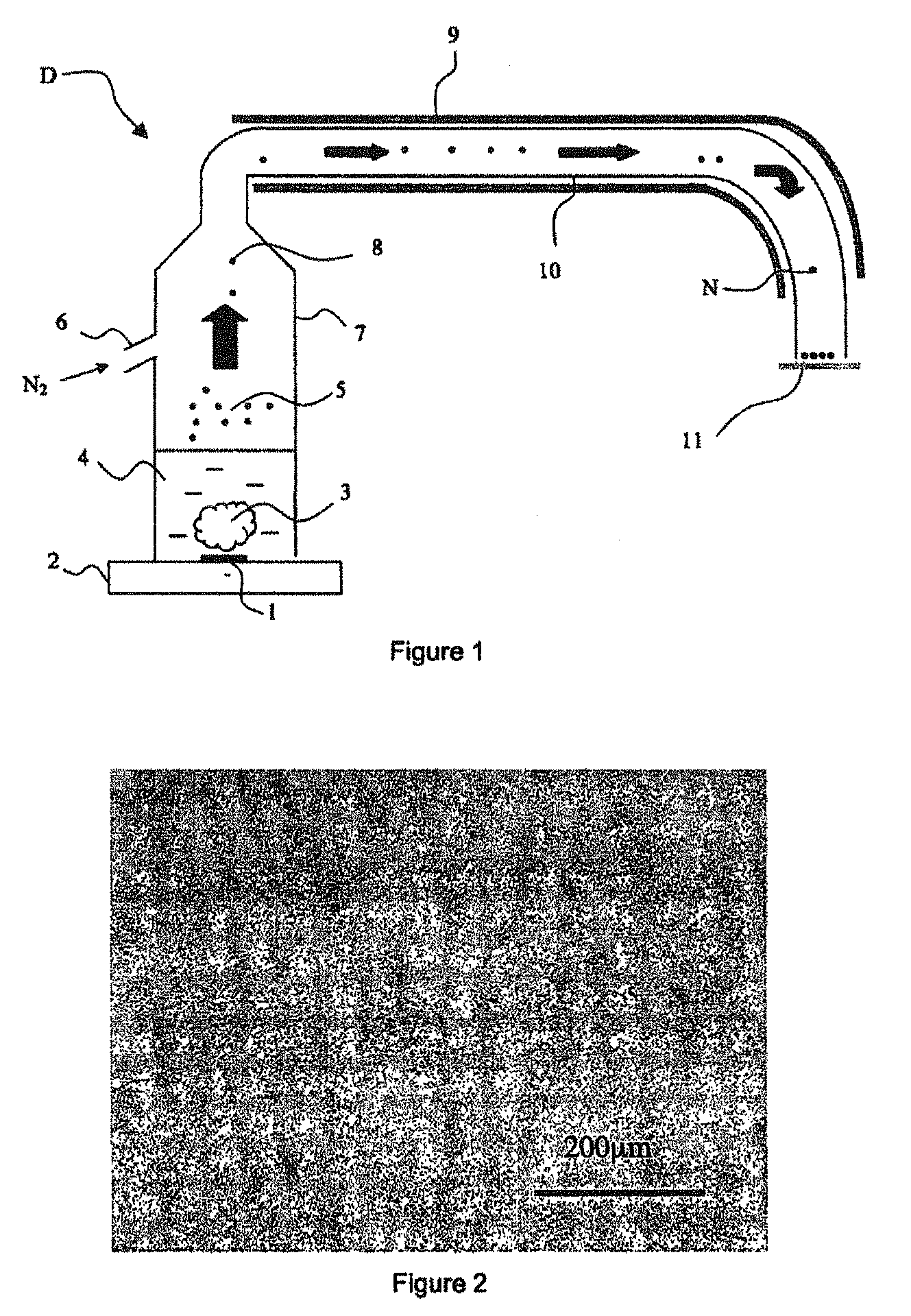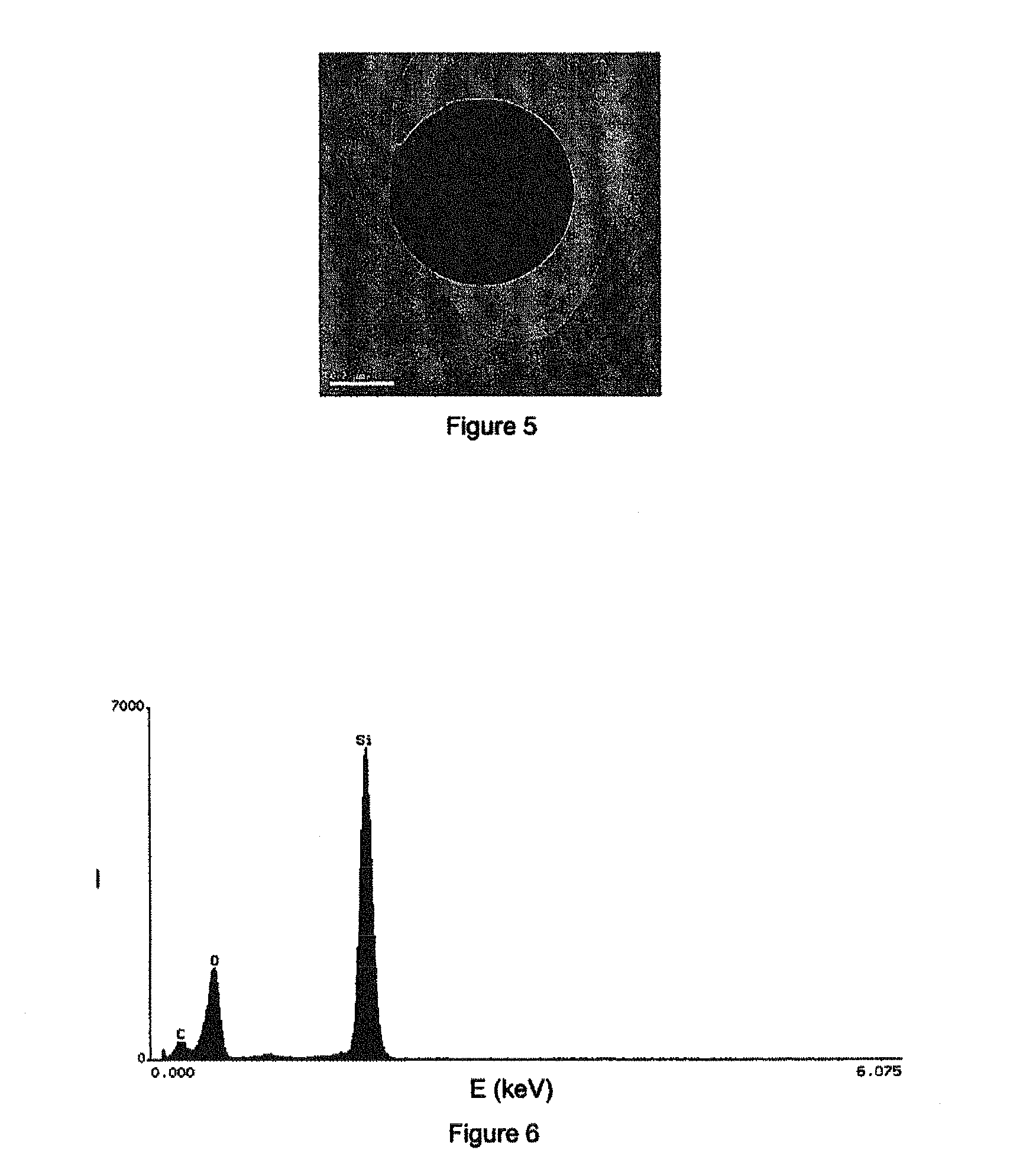Fluorescent nanocrystals encapsulated in an inorganic shell
a fluorescent nanocrystal and inorganic shell technology, applied in the field of fluorescent nanocrystals encapsulated in an inorganic shell, can solve the problems of insufficient imaging contrast during deep blood vessel studies, difficult to graft a large number of fluorophores onto the same polymeric aggregate, etc., and achieve shallow blood vessel imaging (about one mm deep) but remain insufficient for deep examination of permeable and lesioned capillaries
- Summary
- Abstract
- Description
- Claims
- Application Information
AI Technical Summary
Benefits of technology
Problems solved by technology
Method used
Image
Examples
example 1
Synthesis of Rubrene Nanocrystals Coated with a Silicate Shell
[0125]In this example, rubrene is chosen for the production of organic nanocrystals included in silica spheres. Rubrene has orange-red luminescence (wavelength band from 550 to 600 nm) for which biological tissues show good transparency.
[0126]The synthesis of the nanoparticles of the present invention according to the process of the present invention is illustrated by FIG. 1 which represents the reactor (7) comprising a sol-gel mixture (4). The sol-gel mixture (4), after nebulization, leads to the aerosol (5) formed from droplets (8). The gas inlet (6) allows transfer of the aerosol to the area (10) for drying the aerosol surrounded with a heating resistance (9). Once dried, the nanoparticles (N) of the invention are collected by means of a glass plate (11).
Procedure for Preparing the Sol-Gel Mixture (4):
[0127]The microcrystalline rubrene powder (0.18 g; 3.3 mmol; sold by the company Aldrich) was dissolved in a solution c...
example 2
Synthesis of Cyano-Methoxy-Nitro-Stilbene (CMONS) Nanocrystals Coated with a Titanium Oxide Shell
[0148]The procedure of Example 1 is repeated with, in this example, a sol-gel mixture (4) prepared from:[0149]0.65 g (i.e. 2.32 mmol) of cyano-methoxy-nitro-stilbene (CMONS);[0150]140 mL (i.e. 1.7 mol) of tetrahydrofuran (THF) solvent;[0151]10.06 mL (i.e. 3.3×10−2 mol) of titanium iso-propoxide as sol-gel precursor;[0152]2.46 mL of a solution of hydrochloric acid in water (of concentration 0.1 M), i.e. 0.14 mol of water.
[0153]After nebulization of the sol-gel mixture and drying of the aerosol according to the method described in Example 1, the titanate nanoparticles are collected in a yield of about 30% by mass of nanoparticles.
example 3
Synthesis of Cyano-Methoxy-Nitro-Stilbene (CMONS) Nanocrystals Coated with a Silicate Shell
[0154]In this example, the conditions for synthesizing the nanoparticles according to the invention are as follows:[0155]the silicate matrix is formed from 50% of tetra-methoxysilane (TMOS, Si(OCH3)4) and 50% of methyl-trimethoxysilane (MTMOS, CH3Si(OCH3)3),[0156]the amount of chromophore (CMONS) used for the synthesis (or ratio of the concentration of CMONS to the concentration of silicon alkoxide) is d=[CMONS] / [silicon alkoxide]=0.05,[0157]the degree of dilution (ratio of the concentration of solvent to the concentration of silicon alkoxide) is s=[solvent] / [silicon alkoxide]=50,[0158]the acid catalysis is performed at a pH below 2,[0159]the degree of hydrolysis (ratio of the concentration of water to the concentration of alkoxide functions (—OR2) originating from the metal alkoxides TMOS and MTMOS) is h=[H2O] / [—OR2]=1 (the concentrations are calculated on the basis of the initial mixture, in...
PUM
| Property | Measurement | Unit |
|---|---|---|
| excitation wavelength | aaaaa | aaaaa |
| wavelengths | aaaaa | aaaaa |
| wavelengths | aaaaa | aaaaa |
Abstract
Description
Claims
Application Information
 Login to View More
Login to View More - R&D
- Intellectual Property
- Life Sciences
- Materials
- Tech Scout
- Unparalleled Data Quality
- Higher Quality Content
- 60% Fewer Hallucinations
Browse by: Latest US Patents, China's latest patents, Technical Efficacy Thesaurus, Application Domain, Technology Topic, Popular Technical Reports.
© 2025 PatSnap. All rights reserved.Legal|Privacy policy|Modern Slavery Act Transparency Statement|Sitemap|About US| Contact US: help@patsnap.com



